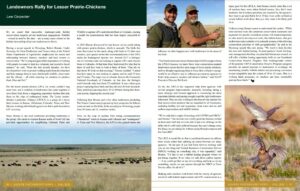
It’s no secret that successful, landscape-scale habitat conservation requires private landowner engagement. Wildlife – owned in trust by the state – are in many cases reliant on the habitat stewardship of private landowners to thrive.
During a recent speech in Wyoming, Robert Bonnie, Under Secretary for Farm Production and Conservation at the United States Department of Agriculture, emphasized the nature and relationship between farmers, ranchers and land owners to conservation. “We’ve long recognized the importance of working with people to conserve land in a voluntary and incentive-based manner,” he said. “Over the last several decades, we have developed new tools to protect working lands from development and help manage them in ways that benefit wildlife, clean water and the climate – all while ensuring we continue to produce food, fiber and fuel.”
For the lesser prairie-chicken (LPC), his words couldn’t ring more true, and a coalition of landowners has come together to save these birds from a staggering population decline that puts them on the edge of endangered status. The Lesser prairie-chicken Landowner Alliance (LPCLA) is a group of a dozen land owners in Kansas, Oklahoma, Colorado, Texas and New Mexico working with federal agencies to find a path forward on LPC recovery.
